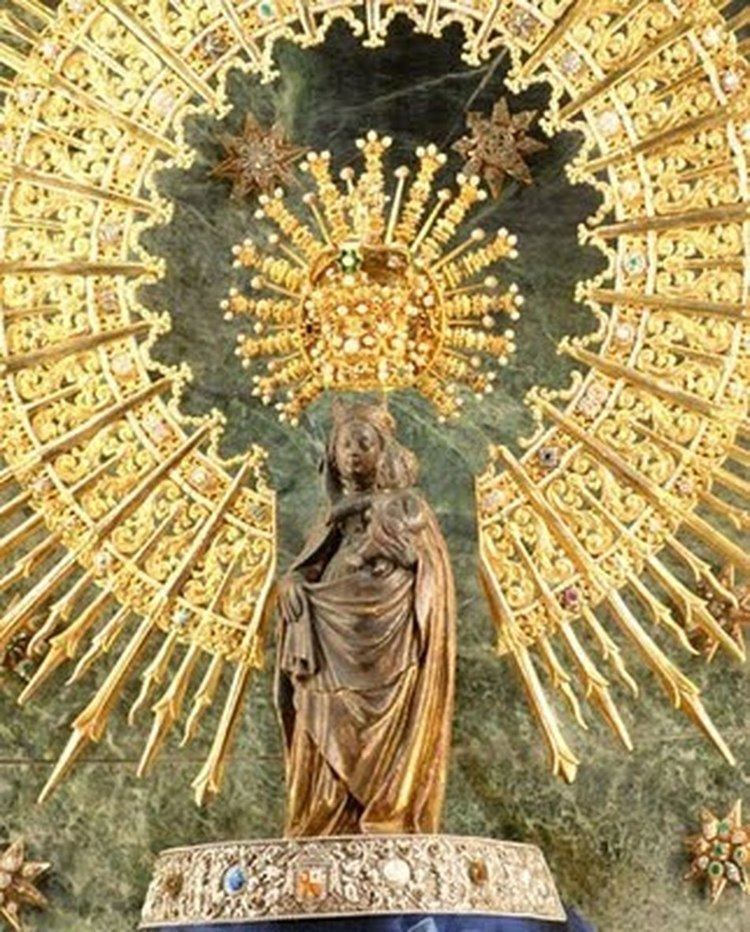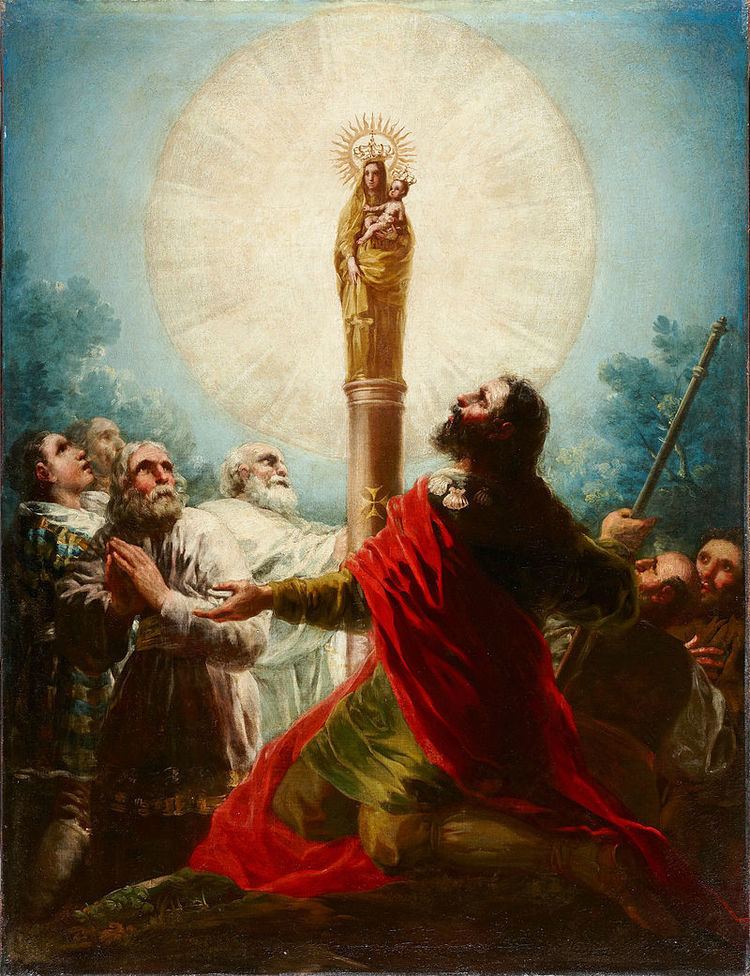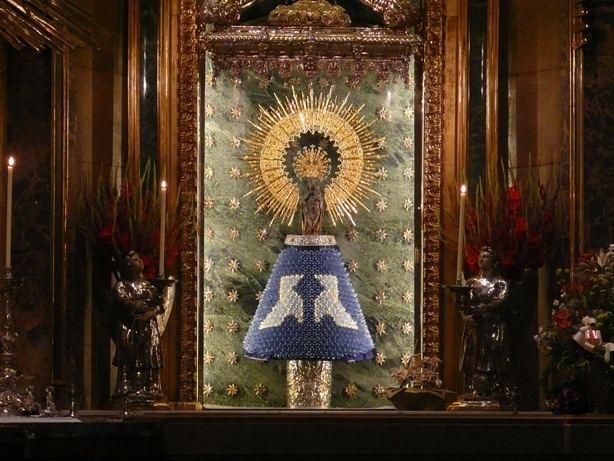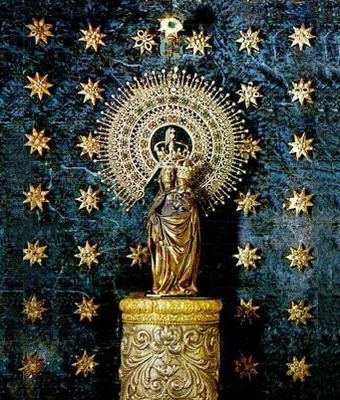Type Marian Apparition | Date 12 October 40 AD Year 12 October 40 AD | |
 | ||
Holy See approval Pope Callixtus IIIPope Pius X Patronage Zaragoza, Spain, Melo, Uruguay, Buenos Aires, Argentina, Imus, Cavite, Zamboanga City, Santa Cruz, Manila, Alaminos, Laguna, San Simon, Pampanga, Libmanan, Camarines Sur, Pilar and Morong in Bataan, Mamburao, Occidental Mindoro, Sibonga, Cebu | ||
Our Lady of the Pillar (Spanish: Nuestra Señora del Pilar) is the name given to the Blessed Virgin Mary in connection with an ancient Spanish tradition that she appeared to the Apostle James the Greater as he was praying by the banks of the Ebro at Zaragoza. Mary is often depicted carrying the Christ Child on her arms resting above a pillar, sometimes carried by angelic cherubs.
Contents
- Marian shrines of the world 13 our lady of the pillar
- History
- Apparition
- Approval
- Description of the image and pillar
- The Shrine to Our Lady of the Pillar
- Feast day
- Veneration of Our Lady of the Pillar around the world
- South America
- Philippines
- References

The Virgin Mary is invoked under this title as the Patroness of Spain, of the Spanish Civil Guard and of the Hispanic world. The celebrated wooden image is enshrined at the Basilica of Our Lady of the Pillar in Zaragoza. The statue was granted a Canonical Coronation by Pope Saint Pius X on 20 May 1905.

Marian shrines of the world 13 our lady of the pillar
History

Christian tombs at Saragossa, dating from Roman days, appear to bear images representing the Assumption of the Blessed Virgin. The oldest written testimony of devotion to the Blessed Virgin in Saragossa is usually identified as that of Pedro Librana in 1155.
Apparition

According to ancient Spanish tradition, on 12 October 40 AD, in the early days of Christianity, James the Greater, one of the original Twelve Apostles of Jesus Christ, was preaching the Gospel in what was then the pagan land of Zaragoza, in the Roman province of Hispania. He was disheartened with his mission, having made only a few converts. While he was praying by the banks of the Ebro River with some of his disciples, Mary miraculously appeared before him atop a pillar accompanied by angels. Mary and Angels performed a variety of most unnatural activities and assured James that the people would eventually be converted and their faith would be as strong as the pillar she was standing on. She gave him the pillar as a symbol and a wooden image of herself. James was also instructed to build a chapel on the spot where she left the pillar.

After establishing the church, James returned to Jerusalem with some of his disciples where he became a martyr, beheaded in 44 AD during the reign of Herod Agrippa. His disciples allegedly returned his body to Spain.
Approval
The apparition of Our Lady of the Pillar is a widely accepted tradition. Popes from earliest times issued Papal Bulls attesting to the authenticity of the shrine and the appearance of the Virgin Mary. Pope Calixtus III issued a bull in 1456 encouraging pilgrimage to the Lady of the Pillar. It acknowledged the miracle of its foundation and the miracles that had taken place in the Spanish shrine. It was also through this bull that the name Lady of the Pillar was confirmed.
So many contradictions had arisen concerning the miraculous origin of the church that during the reign of Pope Innocent XIII Spain appealed to the Holy See to settle the controversy. After careful investigation, the twelve cardinals, in whose hands the affair rested, adopted the following account, which was approved by the Sacred Congregation of Rites on 7 August 1723, and later inserted in the lessons of the office of the feast of our Lady of the Pillar, celebrated on 12 October:
Of all the places that Spain offers for the veneration of the devout, the most illustrious is doubtless the sanctuary consecrated to God under the invocation of the Blessed Virgin, under the title of our Lady of the Pillar, at Saragossa.
According to ancient and pious tradition, St. James the Greater, led by Providence into Spain, spent some time at Saragossa. He there received a signal favor from the Blessed Virgin. As he was praying with his disciples one night, upon the banks of the Ebro, as the same tradition informs us, the Mother of God, who still lived, appeared to him, and commanded him to erect an oratory in that place. The apostle delayed not to obey this injunction, and with the assistance of his disciples soon constructed a small chapel. In the course of time a larger church was built and dedicated, which, with the dedication of Saint Saviour's, is kept as a festival in the city and Diocese of Saragossa on the 4th of October.
Pope Clement XII allowed the celebration of the feast of Our Lady of the Pillar all over the Spanish Empire in 1730. As the date coincides with the discovery of the Americas, the lady was later named as Patroness of the Hispanic World.
Description of the image and pillar
The pillar left by the Virgin Mary is presently enshrined in the same but larger Basilica of Our Lady of the Pillar. It is believed to be the same pillar given and promised by Mary, in spite of numerous disasters that beset the church. A fire in 1434 burned down the church that preceded the present basilica.
The image of the Blessed Virgin Mary may or may not be the original. Some reports state that the original wooden image was destroyed when the church burned down in 1434, contradicting other reports that it is still the original statue. The statue of the Blessed Virgin Mary is made of wood and stands 39 centimetres (15 in) tall while the 6 feet (1.8 m) pillar is made of jasper. The statue depicts Mary with the Child Jesus on her left arm, who has a dove sitting on his left palm. Since the 16th century, the pillar is usually draped in a skirt-like cover called manto (in English: mantle). As a whole, it is protected by a bronze case and then another case of silver. The image was canonically crowned in 1905 during the reign of Pope Pius X. The crown was designed by the Marquis of Griñi, valued at 450,000 pesetas (£18,750, 1910).
The Shrine to Our Lady of the Pillar
The construction of the present Basilica of Our Lady of the Pillar, Zaragosa was started in 1681 and ended in 1711. Later additions in the 18th century expanded its dimensions to the present 130 metres (430 ft) in length, by 67 metres (220 ft) in width, crowned by eleven cupolas, four towers, and ten lantern towers. The cathedral was elevated to Minor Basilica status during the reign of Pope Pius XII in the 1950s.
During the Spanish Civil War, two bombs hit and damaged the basilica but neither exploded. The event was reckoned a miracle, and the defused bombs have been on display at the basilica premises ever since.
Feast day
The feast of Our Lady of the Pillar is celebrated on 12 October and she is the Patroness of the Hispanic peoples and the Spanish Civil Guard. A grand nine-day festival known as Fiestas del Pilar is celebrated in Zaragoza every year in her honor. The feast of the Lady of the Pillar is also a national holiday in Spain as it coincides with the Fiesta Nacional de España, which commemorates the arrival of Christopher Columbus in the Americas in 1492.
Veneration of Our Lady of the Pillar around the world
Pilar, short for Maria del Pilar, is a common Spanish given name, with name day on the feast of Our Lady of the Pillar.
South America
Philippines
In the Philippines, ruled by Spain for over three hundred years, Our Lady of the Pillar is honored as the patroness of a number parishes and municipalities; seven are named Pilar in her honor. There are towns named Pilar in the provinces of Abra, Bataan, Bohol, Capiz, Cebu, Surigao del Norte and Sorsogon. As in Spain, her feast day is celebrated every 12 October.
